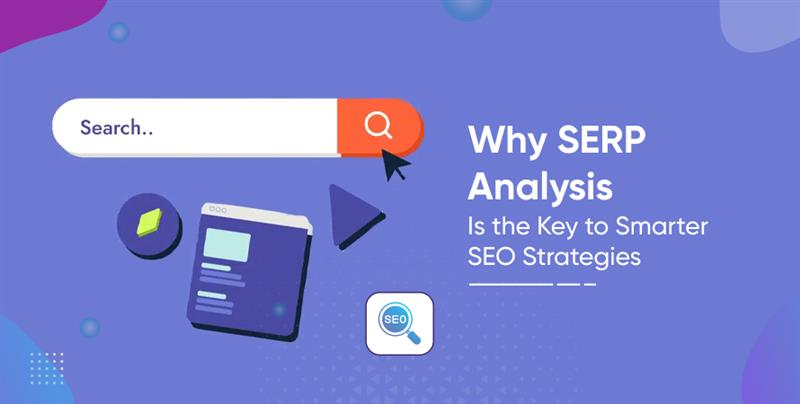Why SERP Analysis Is the Key to Smarter SEO Strategies



In today’s digital landscape, ranking on Google isn’t just about optimizing keywords or building backlinks. It’s about understanding what the search engine is already rewarding. This is where SERP analysis comes into play.
If you’ve been publishing content without reviewing the search engine results pages for your target keywords, you’re missing out on crucial insights that could give your SEO strategy a competitive edge. In this blog, we’ll break down what SERP analysis really is, why it’s critical, and how to start using it effectively.
What Is SERP Analysis?
SERP analysis refers to the process of studying the top-ranking pages on Google (or other search engines) for a particular keyword. The goal is to understand the structure, content type, and format of the pages that are already performing well so you can analyze SERP and replicate or improve upon those strategies.
When you check SERP results manually or using a SERP analyzer, you gain insights into:
- Types of content ranking (e.g., blogs, product pages, videos)
- SERP features such as featured snippets, image packs, and People Also Ask sections
- Title tags and meta descriptions used by top results
- Domain authority of SERP competitors ranking for the same keyword
- Presence of structured data and use of schema markup
- Length, tone, and structure of top-performing content
Unlike traditional keyword research, SERP analysis is about understanding the context and intent behind a keyword—something modern SEO cannot succeed without.
Why SERP Analysis Is Crucial for SEO Success
Google’s algorithm has grown increasingly complex, and it now favors content that satisfies user intent, provides value, and meets technical quality standards. Here’s how SERP analysis supports that:
Aligns Content With Search Intent
When you look at the top results, you’re essentially seeing Google’s answer to the query. This helps you tailor your content accordingly. For example, if all top results for “best laptops 2025” are listicles with reviews, publishing a single-product sales page would likely miss the mark.
Reveals What Google Is Favoring
By reviewing google SERP features, content formats, and ranking patterns, you get to analyse SERP signals and identify what Google currently values for that keyword.
Improves Your On-Page Strategy
With insights from on page analysis, you can optimize your headings, content flow, keyword placement, and user experience—making your page both helpful and SEO-friendly.
Increases Your Chances to Win SERP Features
If a keyword regularly triggers a SERP feature like a featured snippet or a “People Also Ask” box, your goal should be to create content optimized to occupy that space. This can boost SERP visibility dramatically and drive more clicks even if you’re not in position #1.
Helps You Understand the Competitive Landscape
You might think you’re competing with known brands, but SERP analysis shows who your real SERP competitors ranking for the keyword are—sometimes they’re niche blogs or smaller sites that you can realistically outrank.
How SERP Analysis Supports EEAT (Experience, Expertise, Authoritativeness, Trust)
Google’s EEAT guidelines—Experience, Expertise, Authoritativeness, and Trust—play a big role in how content is ranked. SERP analysis helps reinforce each of these pillars:
Experience
By understanding what users are looking for, you can add personal experiences, case studies, or real-world examples that resonate. This makes your content more relatable and trustworthy.
Expertise
Studying the top content allows you to identify knowledge gaps. You can then fill those with expert insights, adding more depth and clarity than the current results provide.
Authoritativeness
When your content reflects a deep understanding of the topic and aligns with what’s already ranking, it sends the right signals to Google. Use internal links, such as explaining how website crawlers work, to build authority across multiple pages.
Trust
Transparent, well-organized, and properly cited content builds trust. Use trusted SERP tools and data sources, and make sure your content structure mirrors successful examples.
Step-by-Step Guide: How to Conduct SERP Analysis
You don’t need to be an SEO expert to perform a good SERP features analysis. Here’s a simplified, actionable guide:
Step 1: Start with a Target Keyword
Open a private browsing window and search your keyword manually. This helps avoid personalized search results.
Step 2: Study the Top 10 Results
Check out the content type, structure, and tone. Use a serps checker or SERP analyzer tool if needed for deeper insights.
Step 3: Identify Content Formats
Are the top results blog posts, videos, or product pages? Align your content type accordingly.
Step 4: Take Note of SERP Features
Record which SERP features appear. Are there featured snippets, site links, or local packs? This shows where opportunities lie.
Step 5: Evaluate Authority
Compare the domain authority of the top-ranking pages. Even if your site is smaller, targeting keywords where low-authority pages rank is a smart move.
Step 6: Perform On-Page Element Analysis
Check title tags, H1s, internal links, images, and meta descriptions. These are all part of a thorough on page analysis.
Step 7: Use the Right Tools
Tools like Ahrefs, SEMrush, and Moz are excellent for check SERP insights, but even manual analysis using browser tools can go a long way.
This process helps you not just match, but surpass the content that’s already ranking.
Common Mistakes to Avoid in SERP Analysis
While SERP analysis is a powerful SEO tool, it’s easy to misuse or underutilize if not approached correctly. Below are some of the most frequent missteps businesses and marketers make, and how to avoid them:
Blindly Copying Top Results
One of the most common mistakes is replicating the top-ranking content word for word or format for format without adding any new value. Google’s algorithm rewards originality and relevance. Instead of copying, look for gaps or outdated sections in existing content, and use your expertise to improve upon them.
This is especially important when dealing with content that impacts the user journey. Incorporating a deeper understanding of customer experience management can help create more user-centric pages that stand out.
Ignoring the Role of Search Intent
Some content creators focus only on keywords and forget to match the SERP keyword with the searcher’s actual intent. If users are looking for step-by-step guides and your page offers only general information, you’re likely to miss the mark. Always align your content with what the SERP search reveals about intent.
Not Tracking Changes in SERP Over Time
SERPs are dynamic. The elements you see today—like SERP features SEO enhancements such as FAQs or carousels—might not be there tomorrow. If you don’t regularly monitor SERP competitors, you risk falling behind to more agile websites that adapt faster to Google’s updates.
Overlooking Technical SEO
Many people dive deep into content strategies but ignore the technical aspects that underpin rankings. Issues like slow load times and crawl inefficiencies hurt your content’s visibility. Understanding how website crawlers work and improving Time to First Byte can dramatically improve crawl rates and indexing.
Final Tips: Making the Most of Your SERP Insights
By now, it’s clear that SERP analysis should be a cornerstone of any solid SEO strategy. But beyond basic analysis, how can you consistently extract value and apply it?
Blend Data with Human Insight
Use tools to check SERP competition, but remember that tools provide data—not interpretation. Use your industry knowledge and brand voice to evaluate what’s actually working for your audience.
If you’re targeting a SERP preview space like a featured snippet, your content should directly answer the query in a clear and concise way. Structure your response in a way that’s scannable, and make use of bullet points or short paragraphs where appropriate.
Keep User Experience Front and Center
SEO is not just about search engines—it’s about creating value for users. That’s why integrating principles of breadcrumb navigation can help both users and Google understand your site’s structure.
When improving your pages, always assess how quickly they load, how readable they are, and how logically information flows. These elements also affect SERP metrics like click-through rate and dwell time, which in turn influence rankings.
Focus on Originality and Value Addition
To rank above your SERP competitor ranking, you need to give users something they can’t find elsewhere. This could be an expert opinion, unique research, or even well-organized information that’s easier to digest.
It also helps to link internally to credible and detailed resources. For example, understanding the role of website crawlers or how to optimize loading times adds depth and supports your EEAT signals.
Build an SEO Culture in Your Organization
Finally, SEO shouldn’t be treated as a one-time activity. Make SERP monitoring, technical audits, and content updates a recurring part of your strategy. Consider consulting with professionals like Hire Core Web Vitals Consultant to keep your technical SEO aligned with the latest Google requirements.
Conclusion
In a competitive digital world, creating great content alone isn’t enough. Understanding what already works in the search engine results through strategic SERP analysis gives you the blueprint to succeed. From evaluating SERP features, analyzing SERP competitor ranking, to ensuring technical readiness, each step adds up to more visibility and better user engagement.
If you’re serious about climbing the ranks and maintaining a long-term presence, this isn’t optional—it’s essential. Start analyzing SERPs regularly, avoid the common pitfalls, and apply your insights with a user-first mindset. That’s how you future-proof your SEO.
Frequently Asked Questions (FAQs)
Google’s helpful content update is a search algorithm change that aims to surface content that is genuinely useful, relevant, and created for humans. It rewards sites that offer in-depth, original insights and devalues content written solely for SEO purposes.
The update uses a site-wide classifier to evaluate the overall helpfulness of a website’s content. If a large portion of your site is deemed unhelpful, your entire domain may experience reduced visibility in search results.
Helpful content:
- Is created for a specific audience
- Demonstrates real-world experience or expertise
- Provides complete, accurate answers
- Is regularly updated and clearly written
Google’s system favors content that puts people first, not search engines.
Yes, it’s part of a broader evolution in SEO where Google continues to prioritize user intent, topical authority, and content experience. The update aligns closely with EEAT—Experience, Expertise, Authoritativeness, and Trustworthiness.
Yes, but with caution. While AI can assist in drafting or researching, the final content must be reviewed and enhanced by humans to reflect real expertise and experience. Over-reliance on AI without added value may result in poor rankings.
To align with the Google new SEO update, focus on:
- Writing detailed, useful content
- Demonstrating first-hand knowledge
- Updating outdated pages
- Removing low-quality or duplicate content
You can also consult with experts like Hire Core Web Vitals Consultant for customized support.